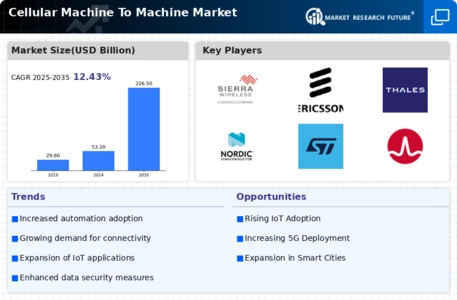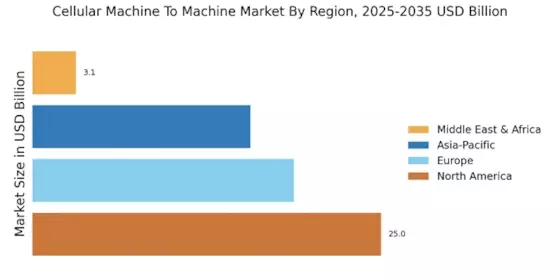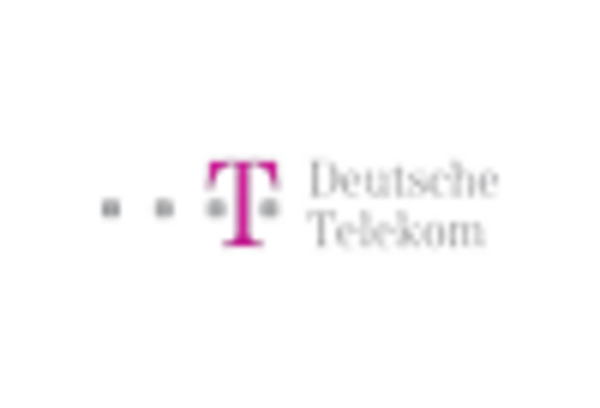Expansion of Smart Cities
The development of smart cities is a critical driver for the Cellular Machine To Machine Market. Urbanization trends indicate that more than half of the world's population now resides in urban areas, leading to increased pressure on infrastructure and services. Smart city initiatives aim to leverage technology to enhance urban living, improve public services, and promote sustainability. Cellular M2M solutions play a vital role in this transformation by enabling smart transportation systems, energy management, and waste management solutions. The market for smart city technologies is expected to reach substantial figures, with investments in M2M communications being a key component. As cities evolve into smart ecosystems, the demand for reliable and efficient cellular M2M connectivity will likely escalate, further propelling the growth of the Cellular Machine To Machine Market.
Emergence of 5G Technology
The rollout of 5G technology is poised to revolutionize the Cellular Machine To Machine Market. With its promise of higher speeds, lower latency, and greater capacity, 5G is expected to enhance the performance of M2M applications significantly. Industries that rely on real-time data processing, such as autonomous vehicles and remote healthcare, stand to benefit immensely from this advancement. The transition to 5G is anticipated to drive substantial investments in M2M infrastructure, as businesses seek to leverage the capabilities of next-generation networks. Analysts predict that the adoption of 5G will lead to a marked increase in M2M connections, further solidifying the Cellular Machine To Machine Market's role in enabling innovative solutions across various sectors.
Growth in Connected Devices
The proliferation of connected devices is a significant catalyst for the Cellular Machine To Machine Market. With the advent of the Internet of Things, the number of devices connected to the internet is expected to reach billions in the near future. This expansion necessitates robust cellular M2M solutions to ensure seamless communication and data transfer among devices. Industries such as healthcare, automotive, and consumer electronics are increasingly integrating M2M technologies to enhance functionality and user experience. Market forecasts suggest that the number of connected devices will continue to grow exponentially, leading to a corresponding increase in demand for cellular M2M services. This trend underscores the importance of the Cellular Machine To Machine Market in supporting the infrastructure required for a connected world.
Rising Demand for Automation
The Cellular Machine To Machine Market is experiencing a notable surge in demand for automation across various sectors. Industries such as manufacturing, logistics, and agriculture are increasingly adopting automated solutions to enhance operational efficiency. This trend is driven by the need to reduce labor costs and improve productivity. According to recent estimates, the automation market is projected to grow significantly, with a compound annual growth rate of over 10% in the coming years. As businesses seek to streamline processes, the integration of cellular M2M technologies becomes essential, facilitating real-time data exchange and remote monitoring. This shift towards automation not only optimizes resource allocation but also fosters innovation, positioning the Cellular Machine To Machine Market as a pivotal player in the broader technological landscape.
Increased Focus on Sustainability
The growing emphasis on sustainability is influencing the Cellular Machine To Machine Market in profound ways. As organizations strive to reduce their carbon footprint and enhance resource efficiency, M2M technologies are being leveraged to monitor and optimize energy consumption, waste management, and supply chain logistics. This trend is particularly evident in industries such as energy and transportation, where M2M solutions facilitate real-time tracking and management of resources. Market data indicates that investments in sustainable technologies are on the rise, with many companies integrating M2M capabilities to achieve their environmental goals. The alignment of M2M technologies with sustainability initiatives not only enhances operational efficiency but also positions the Cellular Machine To Machine Market as a key contributor to the global push for greener practices.


















Leave a Comment